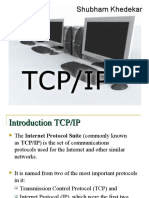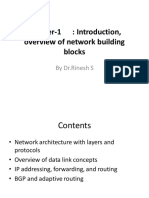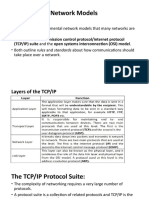0 ratings0% found this document useful (0 votes)
12 viewsLecture4 CAP25
Lecture4 CAP25
Uploaded by
vishal kumarThe TCP/IP model has 4 layers: Application layer (handles protocols like HTTP, FTP, SMTP), Transport layer (uses TCP and UDP for reliable/unreliable transmission), Internet layer (handles routing with IP), and Link layer (manages local delivery and hardware addressing). It combines functions of the OSI model's application, presentation, and session layers into a single application layer.
Copyright:
© All Rights Reserved
Available Formats
Download as PDF, TXT or read online from Scribd
Lecture4 CAP25
Lecture4 CAP25
Uploaded by
vishal kumar0 ratings0% found this document useful (0 votes)
12 views21 pagesThe TCP/IP model has 4 layers: Application layer (handles protocols like HTTP, FTP, SMTP), Transport layer (uses TCP and UDP for reliable/unreliable transmission), Internet layer (handles routing with IP), and Link layer (manages local delivery and hardware addressing). It combines functions of the OSI model's application, presentation, and session layers into a single application layer.
Original Description:
Tcp ip protocol
Original Title
Lecture4_CAP25
Copyright
© © All Rights Reserved
Available Formats
PDF, TXT or read online from Scribd
Share this document
Did you find this document useful?
Is this content inappropriate?
The TCP/IP model has 4 layers: Application layer (handles protocols like HTTP, FTP, SMTP), Transport layer (uses TCP and UDP for reliable/unreliable transmission), Internet layer (handles routing with IP), and Link layer (manages local delivery and hardware addressing). It combines functions of the OSI model's application, presentation, and session layers into a single application layer.
Copyright:
© All Rights Reserved
Available Formats
Download as PDF, TXT or read online from Scribd
Download as pdf or txt
0 ratings0% found this document useful (0 votes)
12 views21 pagesLecture4 CAP25
Lecture4 CAP25
Uploaded by
vishal kumarThe TCP/IP model has 4 layers: Application layer (handles protocols like HTTP, FTP, SMTP), Transport layer (uses TCP and UDP for reliable/unreliable transmission), Internet layer (handles routing with IP), and Link layer (manages local delivery and hardware addressing). It combines functions of the OSI model's application, presentation, and session layers into a single application layer.
Copyright:
© All Rights Reserved
Available Formats
Download as PDF, TXT or read online from Scribd
Download as pdf or txt
You are on page 1of 21
TCP/IP Model
Introduction
• The Internet Protocol Suite (commonly known as
TCP/IP) is the set of communications protocols
used for the Internet and other similar networks.
• It is named from two of the most important
protocols in it:
– Transmission Control Protocol (TCP) and
– Internet Protocol (IP), which were the first two
networking protocols defined in this standard.
Comparison Between TCP/IP and OSI
model
Application Layer
• This layer is comparable to the application,
presentation, and session layers of the OSI
model all combined into one
• It provides a way for applications to have
access to networked services
• It is widely-known layer for the exchange of
user information
Application Layer Contd…
• The Hypertext Transfer Protocol (HTTP) is
used to transfer files that make up the Web
pages of the World Wide Web.
• The File Transfer Protocol (FTP) is used for
interactive file transfer.
• The Simple Mail Transfer Protocol (SMTP) is
used for the transfer of mail messages and
attachments.
Application Layer Contd…
• Presentation Layer does Encryption-
Decryption and Compression-Decompression
of Data
• This layer allows a process to add checkpoints
which are considered as synchronization
points into stream of data
Application Layer Contd…
Transport Layer
• This layer acts as the delivery service used by the
application layer.
• Two protocols used are TCP and UDP.
• The choice is made based on the application's
transmission reliability requirements.
• The transport layer also handles all error detection
and recovery.
Transport Layer Contd…
• It uses checksums, acknowledgements, and
timeouts to control transmissions and end to end
verification
• Unlike the OSI model, TCP/IP treats reliability as
an end-to-end problem
• TCP provides a one-to-one, connection-oriented,
reliable communications service
• UDP provides a one-to-one or one-to-many,
connectionless, unreliable communications
service
Transport Layer Contd…
• A message is divided into segments; each
segment contains sequence number, which
enables this layer in reassembling the
message.
Transport Layer Contd…
• Message is reassembled correctly upon arrival
at the destination and replaces packets which
were lost in transmission
• Connection Control : It includes 2 types :
– Connectionless Transport Layer : Each segment is
considered as an independent packet and delivered
to the transport layer at the destination machine.
– Connection Oriented Transport Layer : Before
delivering packets, connection is made with
transport layer at the destination machine.
Network Layer
• This layer is also known as Internet Layer. The
main purpose of this layer is to organize or
handle the movement of data on network.
• By movement of data, we generally mean
routing of data over the network
• This layer is responsible for addressing,
packaging, and routing functions
Network Layer Contd…
• The core protocols of the Internet layer are IP, ARP,
ICMP, and IGMP.
• The Internet Protocol (IP) is a routable protocol
responsible for IP addressing, routing, and the
fragmentation and reassembly of packets.
• The Address Resolution Protocol (ARP) is
responsible for the resolution of the Internet layer
address to the Network Interface layer address such
as a hardware address.
Network Layer Contd…
• The Internet Control Message Protocol (ICMP) is
responsible for providing diagnostic functions and
reporting errors due to the unsuccessful delivery of
IP packets
• The Internet Group Management Protocol (IGMP) is
responsible for the management of IP multicast
groups.
Network Layer Contd…
• It translates logical network address into physical
address. Concerned with circuit, message or packet
switching.
• Routers and gateways operate in the network layer.
Network Layer Contd…
Data Link Layer
• Data link layer is most reliable node to node
delivery of data
• It forms frames from the packets that are received
from network layer and gives it to physical layer
• It also synchronizes the information which is to be
transmitted over the data. Error controlling is easily
done.
Data Link Layer Contd…
• Protocols of this layer determine which of the
devices has control over the link at any given
time, when two or more devices are connected
to the same link.
Data Link Layer Contd…
• Error control is achieved by adding a trailer at the end of the
frame.
• Duplication of frames are also prevented by using this
mechanism.
• Frames are the streams of bits received from the network
layer into manageable data units.
• This division of stream of bits is done by Data Link Layer.
Physical Layer
• Physical layer is the lowest layer of all. It is
responsible for sending bits from one computer to
another.
• This layer is not concerned with the meaning of the
bits and deals with the physical connection
• This layer defines electrical and physical details
represented as 0 or a 1.
Physical Layer Contd…
• This layer defines the rate of transmission which is
the number of bits per second.
• It deals with the synchronization of the transmitter
and receiver. The sender and receiver are
synchronized at bit level.
• Devices must be connected using the following
topologies: Mesh, Star, Ring and Bus.
• Physical Layer defines the direction of transmission
between two devices: Simplex, Half Duplex, Full
Duplex
You might also like
- Hands On Skills Exam - CCNAv7 ENSA Skills Assessment (Answers)Document17 pagesHands On Skills Exam - CCNAv7 ENSA Skills Assessment (Answers)Reg NdhlovuNo ratings yet
- ASON GMPLS Optical Control Plane TutorialDocument162 pagesASON GMPLS Optical Control Plane Tutorialsrotenstein3114100% (1)
- Winter Semester 2023-24 - CSE3003 - ETH - AP2023246000860 - 2024-01-19 - Reference-Material-IDocument42 pagesWinter Semester 2023-24 - CSE3003 - ETH - AP2023246000860 - 2024-01-19 - Reference-Material-IVinit mehraNo ratings yet
- OSI and TCP IP MODELDocument29 pagesOSI and TCP IP MODELHarsh IsamaliaNo ratings yet
- networkprogrammingDocument14 pagesnetworkprogrammingalmuhtarif.egyptian.yahoo.comNo ratings yet
- Chapter 02 Network ModelsDocument21 pagesChapter 02 Network ModelsFarhan TamzidNo ratings yet
- Introduction TCP/IPDocument23 pagesIntroduction TCP/IPSasi KumarNo ratings yet
- Lect Net10Document31 pagesLect Net10omarmagdyahmed7474No ratings yet
- Shubham KhedekarDocument25 pagesShubham KhedekarSasi KumarNo ratings yet
- Lecture 4Document5 pagesLecture 4kawiragitonga17No ratings yet
- Computer Maintainace and RepairDocument27 pagesComputer Maintainace and Repairmukiibirhines2001No ratings yet
- Reference Material - Chapter 2Document46 pagesReference Material - Chapter 2mitaleeextraNo ratings yet
- CN PPTDocument15 pagesCN PPTrohansengupta22No ratings yet
- Chapter 1Document32 pagesChapter 1Abdirazak ImanNo ratings yet
- Lecture 4, 5 Osi ModelDocument30 pagesLecture 4, 5 Osi Modelahmedmangi543No ratings yet
- Module 1Document151 pagesModule 1tharunn6364No ratings yet
- # TCP/IP Protocol Layers:-1.application Layer: Protocols UsedDocument8 pages# TCP/IP Protocol Layers:-1.application Layer: Protocols UsedPRIYANSHU KUMARNo ratings yet
- UCCN1004 - Lect8 - Intro To Layered Model and ProtocolsDocument31 pagesUCCN1004 - Lect8 - Intro To Layered Model and ProtocolsVickRam RaViNo ratings yet
- Osi ModelDocument20 pagesOsi Modelaneezashahid3469No ratings yet
- What Is The OSI ModelDocument17 pagesWhat Is The OSI ModelBilisumaNo ratings yet
- FALLSEM2023-24 ITA1006 TH VL2023240102674 2023-08-01 Reference-Material-IDocument32 pagesFALLSEM2023-24 ITA1006 TH VL2023240102674 2023-08-01 Reference-Material-IAnanya MachaniNo ratings yet
- Lecture 2 TCP, OSIDocument36 pagesLecture 2 TCP, OSImubeen naeemNo ratings yet
- Network BasicsDocument41 pagesNetwork Basicsdarknetbot307No ratings yet
- cnl2Document93 pagescnl2tasilapoornashreeNo ratings yet
- 21Cs501 Computer Networks: Professional Elective - IDocument95 pages21Cs501 Computer Networks: Professional Elective - Ianusad003No ratings yet
- DC Module 1-2Document35 pagesDC Module 1-2Adam MichelleNo ratings yet
- 19-203-0802 Computer Commu-Nication and Net - Working: Professional Elective - IV SEM-8Document45 pages19-203-0802 Computer Commu-Nication and Net - Working: Professional Elective - IV SEM-8Ťèjùźź ȚèjùNo ratings yet
- FALLSEM2023-24 BCSE308L TH VL2023240100950 2023-04-24 Reference-Material-VDocument28 pagesFALLSEM2023-24 BCSE308L TH VL2023240100950 2023-04-24 Reference-Material-VManan SantokiNo ratings yet
- Chapter 1.1 Fundwementals of Computer NetworkingDocument77 pagesChapter 1.1 Fundwementals of Computer Networkingmikeyas meseretNo ratings yet
- Chapter_TwoDocument39 pagesChapter_TwoFedawak HailuNo ratings yet
- Lecture 6 TCPIPDocument17 pagesLecture 6 TCPIPahmedmangi543No ratings yet
- The OSI Model and Tcp/Ip Protocol SuiteDocument48 pagesThe OSI Model and Tcp/Ip Protocol SuiteJeet KarmakarNo ratings yet
- OSI MODEL AssDocument16 pagesOSI MODEL AssMatovu HerbertNo ratings yet
- Fig.1.14 Logical Connections Between Layers of The TCP/IP Protocol SuiteDocument34 pagesFig.1.14 Logical Connections Between Layers of The TCP/IP Protocol SuiteNadeem PashaNo ratings yet
- Lecture 5Document10 pagesLecture 5AyushNo ratings yet
- Reference ModelDocument21 pagesReference Model9923008050No ratings yet
- Lecture 5 - 6 Data Communication and Networking: BY Muhammad AfzalDocument36 pagesLecture 5 - 6 Data Communication and Networking: BY Muhammad AfzalHamzah AkhtarNo ratings yet
- Lec 1 Classification of ComputersDocument29 pagesLec 1 Classification of ComputersKhawaja RameezNo ratings yet
- Wedding Planner TemplateDocument48 pagesWedding Planner Templatedsibonginkosi2No ratings yet
- 2 Osi-TcpipDocument62 pages2 Osi-TcpipTutun Juhana100% (1)
- Cloud NetworkingDocument26 pagesCloud NetworkingHeliosNo ratings yet
- NetworkDocument82 pagesNetworkDavidoffNo ratings yet
- Fundamental Network ModelsDocument9 pagesFundamental Network ModelsSailas Khulumani TshabanguNo ratings yet
- Tcp-Ip ModelDocument3 pagesTcp-Ip ModelTaimoor ZubairNo ratings yet
- CN ImpDocument32 pagesCN Impblkhackr1jNo ratings yet
- OSI Reference ModelDocument34 pagesOSI Reference Modeleliasalebachew2No ratings yet
- Lesson 4 -OSI ModelDocument15 pagesLesson 4 -OSI Modelemanuelokala5No ratings yet
- 5Document40 pages5ty juNo ratings yet
- TCP MPDocument20 pagesTCP MPsonavanepraniteeNo ratings yet
- Data Comunication CH 1Document22 pagesData Comunication CH 1Desalegn sirnaNo ratings yet
- Lecture 3Document50 pagesLecture 3NANDINI AGGARWAL 211131No ratings yet
- CCN Part 2Document13 pagesCCN Part 2116TanzeelNo ratings yet
- Chapter 2. Network Fundamental ConceptsDocument125 pagesChapter 2. Network Fundamental ConceptsBereketNo ratings yet
- Unit 2 Network ModelDocument78 pagesUnit 2 Network Modelmichaljonny02No ratings yet
- Network Protocol and TCPDocument5 pagesNetwork Protocol and TCPJoshua SantillanaNo ratings yet
- Data Comm & NetworkingDocument8 pagesData Comm & NetworkingTea BletaNo ratings yet
- Unit2Part2 (1)Document37 pagesUnit2Part2 (1)Ghanshyam DhakadNo ratings yet
- Network Protocol ArchitecturesDocument17 pagesNetwork Protocol Architecturesamash.emillyNo ratings yet
- Osi ModelDocument19 pagesOsi ModelPranav SaiNo ratings yet
- Internet Architecture and Performance MetricsDocument14 pagesInternet Architecture and Performance MetricsnishasomsNo ratings yet
- OSI Reference ModelDocument38 pagesOSI Reference Modelpriyasingh1682No ratings yet
- Introduction to Internet & Web Technology: Internet & Web TechnologyFrom EverandIntroduction to Internet & Web Technology: Internet & Web TechnologyNo ratings yet
- CS3 Backup ٢٠٢٤ ٠٢ ١٧ ٢٢ ٥٢Document3 pagesCS3 Backup ٢٠٢٤ ٠٢ ١٧ ٢٢ ٥٢casaarena877No ratings yet
- 2.2 Quality of ServiceDocument12 pages2.2 Quality of ServiceJoshua MNo ratings yet
- Data Communication Case StudyDocument28 pagesData Communication Case StudyRazman OthmanNo ratings yet
- Arelion Peering Policy Clean (12.22Document4 pagesArelion Peering Policy Clean (12.22sergedjimNo ratings yet
- eWON SiemensDocument25 pageseWON SiemensJose PalomoNo ratings yet
- 1.0.1.2 Class Activity - Draw Your Concept of The Internet InstructionsDocument469 pages1.0.1.2 Class Activity - Draw Your Concept of The Internet InstructionsNabil MesbahiNo ratings yet
- The All New Switch Book (Dragged)Document1 pageThe All New Switch Book (Dragged)HagemaruNo ratings yet
- Ngaf M4500Document2 pagesNgaf M4500sigit pamungkasNo ratings yet
- Catalyst 5000 Family - Multilayer SwitchesDocument28 pagesCatalyst 5000 Family - Multilayer SwitchesRobison Meirelles juniorNo ratings yet
- Email FraudulentoDocument11 pagesEmail FraudulentoJano Pizarro MartinezNo ratings yet
- Grupo 23 - Tarea 4Document23 pagesGrupo 23 - Tarea 4alexis pedrozaNo ratings yet
- Generic Communication Protocols Evaluation: Intro To Restful Api and JsonDocument15 pagesGeneric Communication Protocols Evaluation: Intro To Restful Api and Jsonjankos11No ratings yet
- Path Vector RoutingDocument2 pagesPath Vector Routingbakh777196No ratings yet
- NetBackup Appliance Decommissioning and Reconfiguration Guide - 3.1Document44 pagesNetBackup Appliance Decommissioning and Reconfiguration Guide - 3.1Avipan87No ratings yet
- Chapter 21: Troubleshooting Wireless Connectivity: Instructor MaterialsDocument30 pagesChapter 21: Troubleshooting Wireless Connectivity: Instructor MaterialsalidemonNo ratings yet
- CN Lec2Document49 pagesCN Lec2shakirshums12No ratings yet
- Netgear AC3000 ManualDocument214 pagesNetgear AC3000 ManualCliff BurtonNo ratings yet
- Connectin SoMove Lite Via Ethernet - IP Card - FAQDocument5 pagesConnectin SoMove Lite Via Ethernet - IP Card - FAQphongNo ratings yet
- Cisco ME 3400E-24TS-MDocument20 pagesCisco ME 3400E-24TS-MMagna Voce KamarakórusNo ratings yet
- Patel Raj Kailashbhai - Network EngineerDocument1 pagePatel Raj Kailashbhai - Network EngineerRaj K. PatelNo ratings yet
- Data Communications AssignmentDocument4 pagesData Communications AssignmentbuTchaNo ratings yet
- CCNA 1 Final Exam Answers 2019 (v5.1+v6.0) Introduction To NetworksDocument67 pagesCCNA 1 Final Exam Answers 2019 (v5.1+v6.0) Introduction To NetworksJamal ZaghmoutNo ratings yet
- Creating A Connection SAPDocument5 pagesCreating A Connection SAPzafrinNo ratings yet
- Brksec 2050Document146 pagesBrksec 2050Majnu Sm100% (1)
- MEF CECP - Sample Practice Questions Vol 1Document5 pagesMEF CECP - Sample Practice Questions Vol 1basanze100% (2)
- AscenLink 700Document3 pagesAscenLink 700Juan Fabian BarrientosNo ratings yet
- What Is An IP AddressDocument5 pagesWhat Is An IP AddressM.h. PulokNo ratings yet
- The Nmcli ToolDocument8 pagesThe Nmcli ToolByomkesh BakshiNo ratings yet

























































































